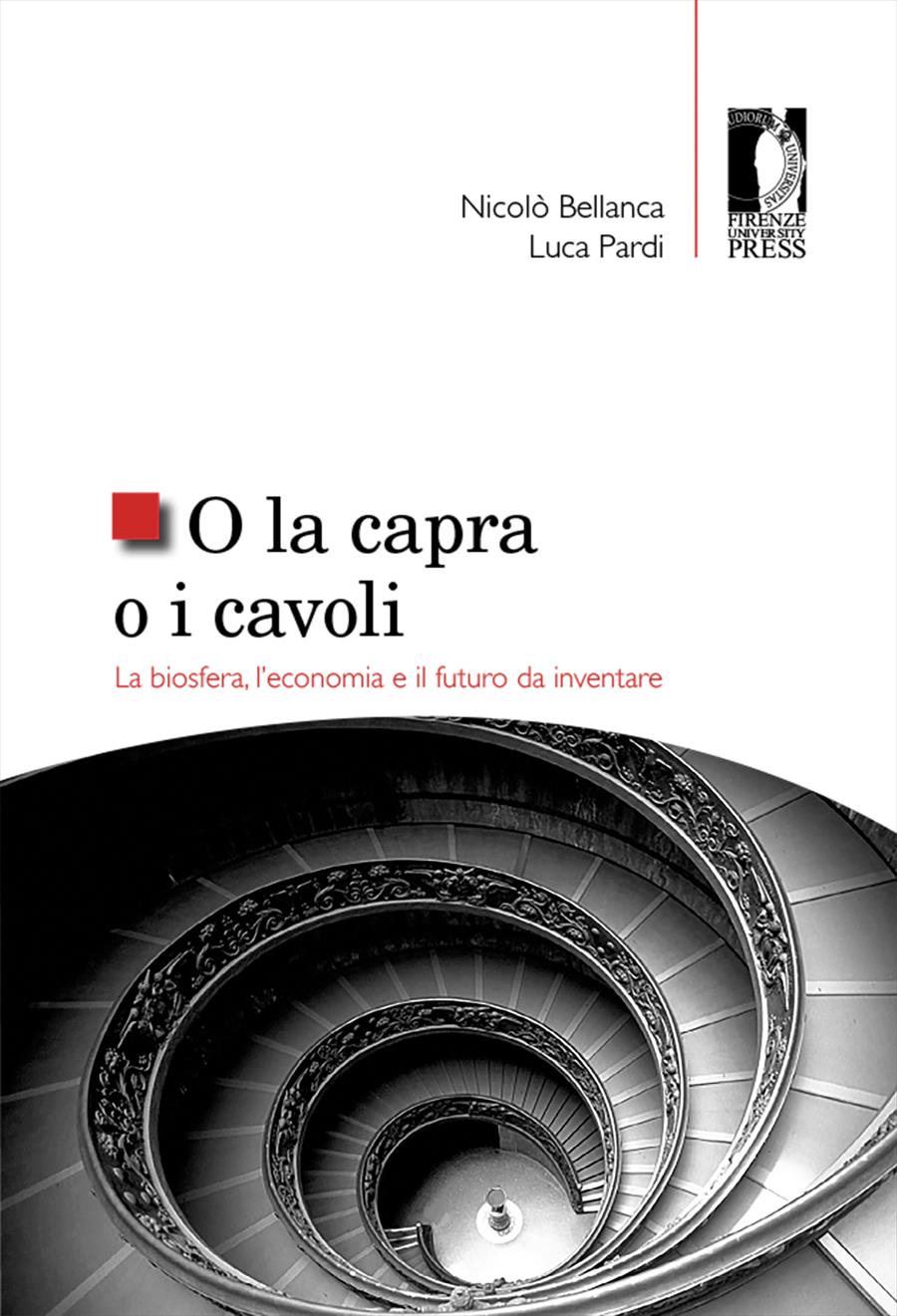- O la capra o i cavoli
- Nicolò Bellanca, Luca Pardi
Il degrado della biosfera
- Nicolò Bellanca
- Luca Pardi
- © 2020 Author(s) |
- CC BY 4.0
- DOI: 10.36253/978-88-5518-195-2.07
The position of man in the biosphere and the interaction of its activities with the different sectors of the earth's ecosphere are bringing the Earth system into a drastically different state from that in which the development of advanced civilizations was possible.
- Keywords:
- Planetary boundaries,
- evolutionary fitness,
- biosphere,
- ecological footprint,
- carrying capacity,
- mass extinction,
University of Florence, Italy - ORCID: 0000-0002-3809-3455
CNR-IPCF, Institute for Chemical-Physical Processes, Italy - ORCID: 0000-0002-6870-1490
- O. Akizu-Gardoki et al., Decoupling between Human Development and Energy Consumption within Footprint Accounts, “Journal of Cleaner Production”, 202, 2018, pp. 1145-1157.
- A. D. Barnosky, Assessing the Causes of Late Pleistocene Extinctions on the Continents, “Science”, 306 (5693), 2004.
- J.C. J.M. van den Bergh e F. Grazi, Ecological footprint policy? Land use as an environmental indicator, “J. Ind. Ecol.”, 18 (1), 2014, pp. 10-19;
- J.C. J.M. van den Bergh e F. Grazi, Reply to the first systematic response by the Global FootprintNetwork to criticism: A real debate finally?, “Ecological Indicators”, 58, 2015, pp. 458-463.
- J. H. Brown et al., Equal fitness paradigm explained by a trade-off between generation time and energy production rate, “Nature Ecology & Evolution”, 2, 2018.
- J. R. Burger et al., Extra-metabolic energy use and the rise in human hyper-density, “Scientific Reports”, 7, 2017. DOI: 10.1038/srep43869
- G. Ceballos et al., Biological Annihilation via the Ongoing Sixth Mass Extinction Signaled by Vertebrate Population Losses and Declines, “Proc Nat Acad Sci USA”, 114 (30), 2017, pp. E6089-E6096.
- F. S. Chapin et al., Principles of Terrestrial Ecosystem Ecology, Springer, New York 2011.
- K. H. Erb et al., Analyzing the Global Human Appropriation of Net Primary Production - Processes, Trajectories, Implications, “Ecological Economics”, 69 (2), 2009.
- B. Etkin, A State Space View of the Ice Ages. A New Look at Familiar Data, “Climatic Change”, 100 (3-4), 2010, pp. 403-406.
- M. Giampietro e A. Saltelli, Footprints to nowhere, “Ecological Indicators”, 46, 2014, pp. 610-621.
- Global Footprint Network, <https://www.footprintnetwork.org/> (09/20).
- H. Haberl et al., Human Appropriation of Net Primary Production: Patterns, Trends, and Planetary Boundaries, “Annu. Rev. Environ. Resour.”, 39 (1), 2014, pp. 363-391.
- A. Kleidon, Life, Hierarchy, and the Thermodynamic Machinery of Planet Earth, “Physics of Life Reviews”, 7 (4), 2010, pp. 424-460.
- E. Kolbert, La sesta estinzione: una storia innaturale, Neri Pozza, Vicenza 2015.
- L. R. Kump et al., The Earth System, Prentice Hall, San Francisco 2010.
- S. Lade et al., Human Impacts on Planetary Boundaries Amplified by Earth System Interactions, “Nat Sustain”, 3 (2), 2020, pp. 119-128.
- S. A. Levin (a cura di), The Princeton Guide to Ecology, Princeton University Press, Princeton 2009.
- A. M. Makarieva et al., Energy Budget of the Biosphere and Civilization: Rethinking Environmental Security of Global Renewable and Non-Renewable Resources, “Ecological Complexity”, 5 (4), 2008.
- E. P. Odum et al., Fondamenti di ecologia, Piccin, Padova 2007 (ed. orig. 2006).
- P. J. Richerson et al., Was Agriculture Impossible during the Pleistocene but Mandatory during the Holocene? A Climate Change Hypothesis, “Am. antiq.”, 66 (3), 2001, pp. 387-411.
- J. Rockström e A. Wijkman, Natura in bancarotta: perché rispettare i confini del pianeta, Edizioni Ambiente, Milano 2014.
- J. Rockström et al., Planetary Boundaries: Exploring the Safe Operating Space for Humanity, “Ecology and Society”, 14 (2), 2009. DOI: 10.5751/ES-03180-140232
- L. Sertorio, Vivere in nicchia, pensare globale, Bollati Boringhieri, Torino 2005.
- L. Sertorio e E. Renda, Ecofisica, Bollati Boringhieri, Torino 2009.
- V. Smil, Energy in Nature and Society: General Energetics of Complex Systems, The MIT Press, Cambridge (Mass.) 2008.
- V. Smil, Harvesting the Biosphere: The Human Impact, “Population and Development Review”, 37 (4), 2011, pp. 613-636.
- W. Steffen et al., The Anthropocene: Conceptual and Historical Perspectives, “Proc. R. Soc. A”, 369 (1938), 2011, pp. 842-867.
- W. Steffen et al., The Anthropocene: Are Humans Now Overwhelming the Great Forces of Nature?, “Ambio”, 36(8), 2007, pp. 614-621.
- W. Steffen et al., Planetary Boundaries: Guiding Human Development on a Changing Planet, “Science”, 347 (6223), 2015.
- G. Strona e C. J. A. Bradshaw, Co-Extinctions Annihilate Planetary Life during Extreme Environmental Change, “Sci Rep”, 8 (1), 2018, pp. 1-12.
- P. M. Vitousek et al., Human domination of Earth’s ecosystems, “Science”, 277, 1997.
- M. Wackernagel et al., Tracking the Ecological Overshoot of the Human Economy, “Proceedings of the National Academy of Sciences”, 99 (14), 2002, pp. 9266-9271.
- T. O. Wiedmann et al., The Material Footprint of Nations, “PNAS”, 112 (20), 2015, pp. 6271-6276.
- J. Zalasiewicz et al., Scale and Diversity of the Physical Technosphere: A Geological Perspective, “The Anthropocene Review”, 4 (1), 2017, pp. 9-22.
Chapter Information
Chapter Title
Il degrado della biosfera
Authors
Nicolò Bellanca, Luca Pardi
Language
Italian
DOI
10.36253/978-88-5518-195-2.07
Peer Reviewed
Publication Year
2020
Copyright Information
© 2020 Author(s)
Content License
Metadata License
Bibliographic Information
Book Title
O la capra o i cavoli
Book Subtitle
La biosfera, l’economia e il futuro da inventare
Authors
Nicolò Bellanca, Luca Pardi
Peer Reviewed
Number of Pages
210
Publication Year
2020
Copyright Information
© 2020 Author(s)
Content License
Metadata License
Publisher Name
Firenze University Press
DOI
10.36253/978-88-5518-195-2
ISBN Print
978-88-5518-194-5
eISBN (pdf)
978-88-5518-195-2
Series Title
Studi e saggi
Series ISSN
2704-6478
Series E-ISSN
2704-5919
